ICT706: Data Analytics for E-commerce Sales and Business Growth
VerifiedAdded on 2024/06/03
|18
|1969
|258
Report
AI Summary
This report analyzes the sales data of an e-commerce company to identify factors affecting its performance and provide recommendations for growth. The project employs data mining techniques and regression models to predict sales trends and understand customer behavior across various product categories and geographic regions. Key findings include insights into pricing strategies, shipping options, and customer segmentation. The report recommends focusing on underserved regions, optimizing pricing for toys, offering free shipping, and improving the overall customer experience with faster delivery and diverse payment options. An implementation plan is also proposed to guide the company in adopting these recommendations and achieving its business goals. Desklib provides access to similar solved assignments and past papers for students.
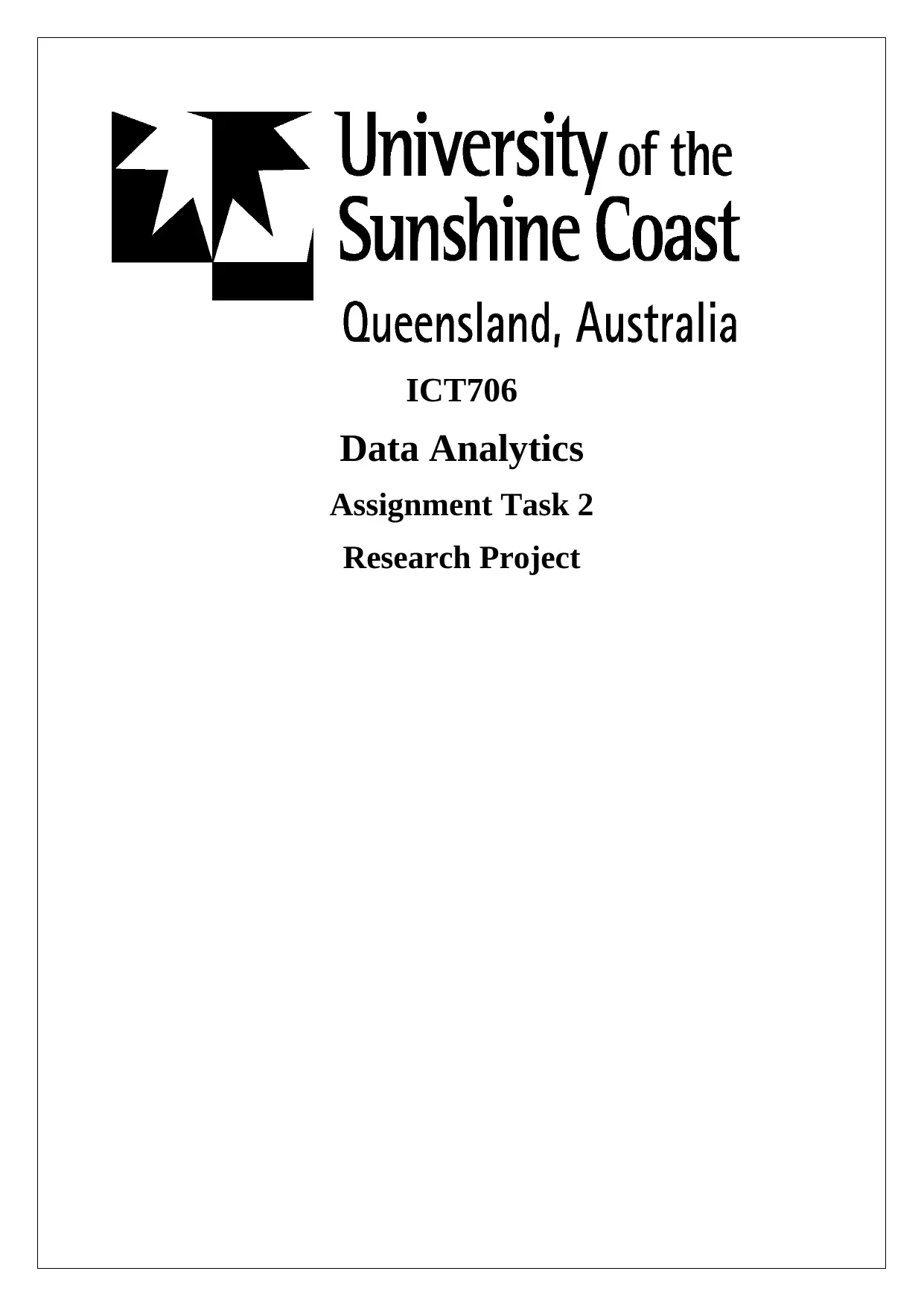
ICT706
Data Analytics
Assignment Task 2
Research Project
Data Analytics
Assignment Task 2
Research Project
Paraphrase This Document
Need a fresh take? Get an instant paraphrase of this document with our AI Paraphraser
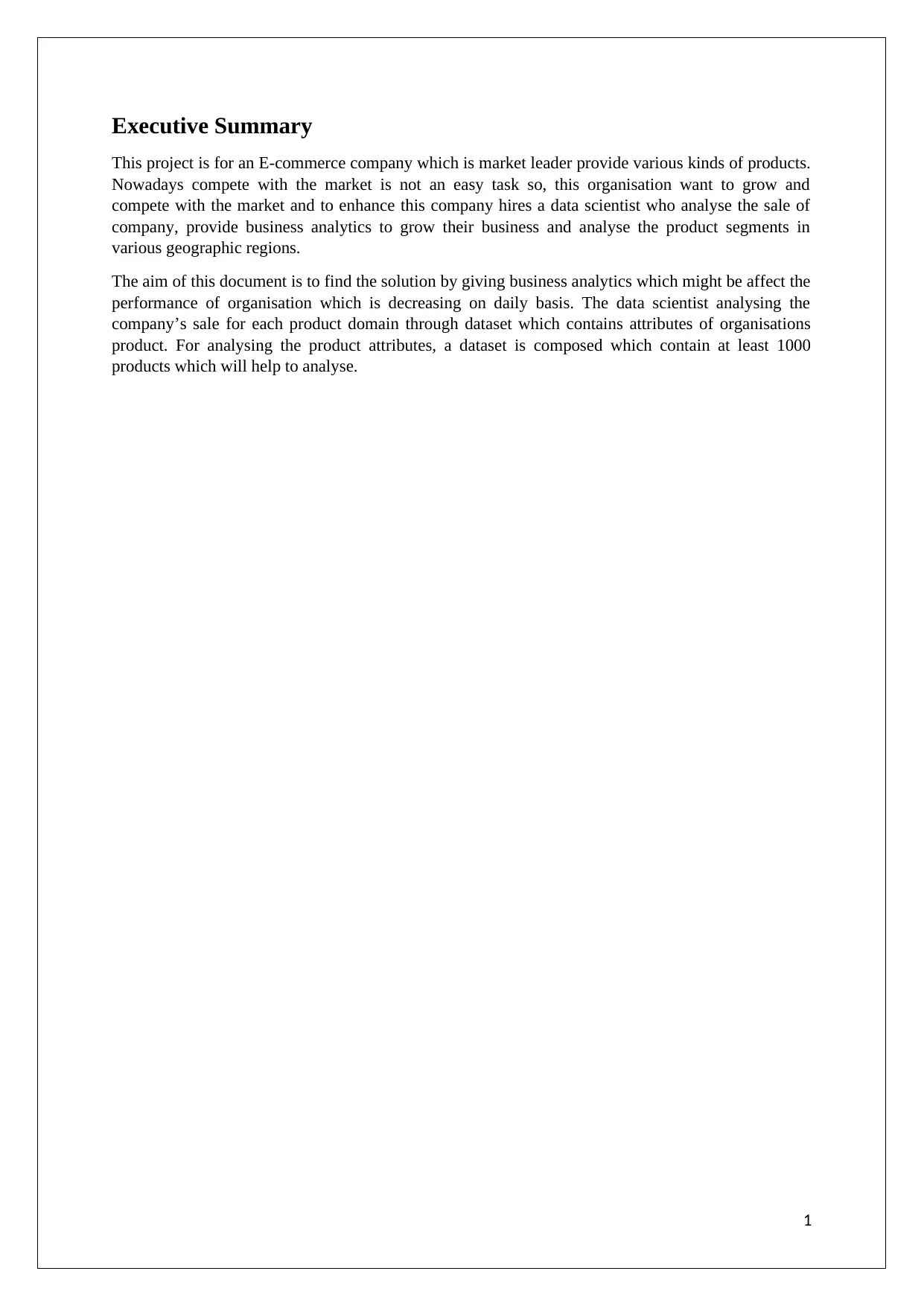
Executive Summary
This project is for an E-commerce company which is market leader provide various kinds of products.
Nowadays compete with the market is not an easy task so, this organisation want to grow and
compete with the market and to enhance this company hires a data scientist who analyse the sale of
company, provide business analytics to grow their business and analyse the product segments in
various geographic regions.
The aim of this document is to find the solution by giving business analytics which might be affect the
performance of organisation which is decreasing on daily basis. The data scientist analysing the
company’s sale for each product domain through dataset which contains attributes of organisations
product. For analysing the product attributes, a dataset is composed which contain at least 1000
products which will help to analyse.
1
This project is for an E-commerce company which is market leader provide various kinds of products.
Nowadays compete with the market is not an easy task so, this organisation want to grow and
compete with the market and to enhance this company hires a data scientist who analyse the sale of
company, provide business analytics to grow their business and analyse the product segments in
various geographic regions.
The aim of this document is to find the solution by giving business analytics which might be affect the
performance of organisation which is decreasing on daily basis. The data scientist analysing the
company’s sale for each product domain through dataset which contains attributes of organisations
product. For analysing the product attributes, a dataset is composed which contain at least 1000
products which will help to analyse.
1
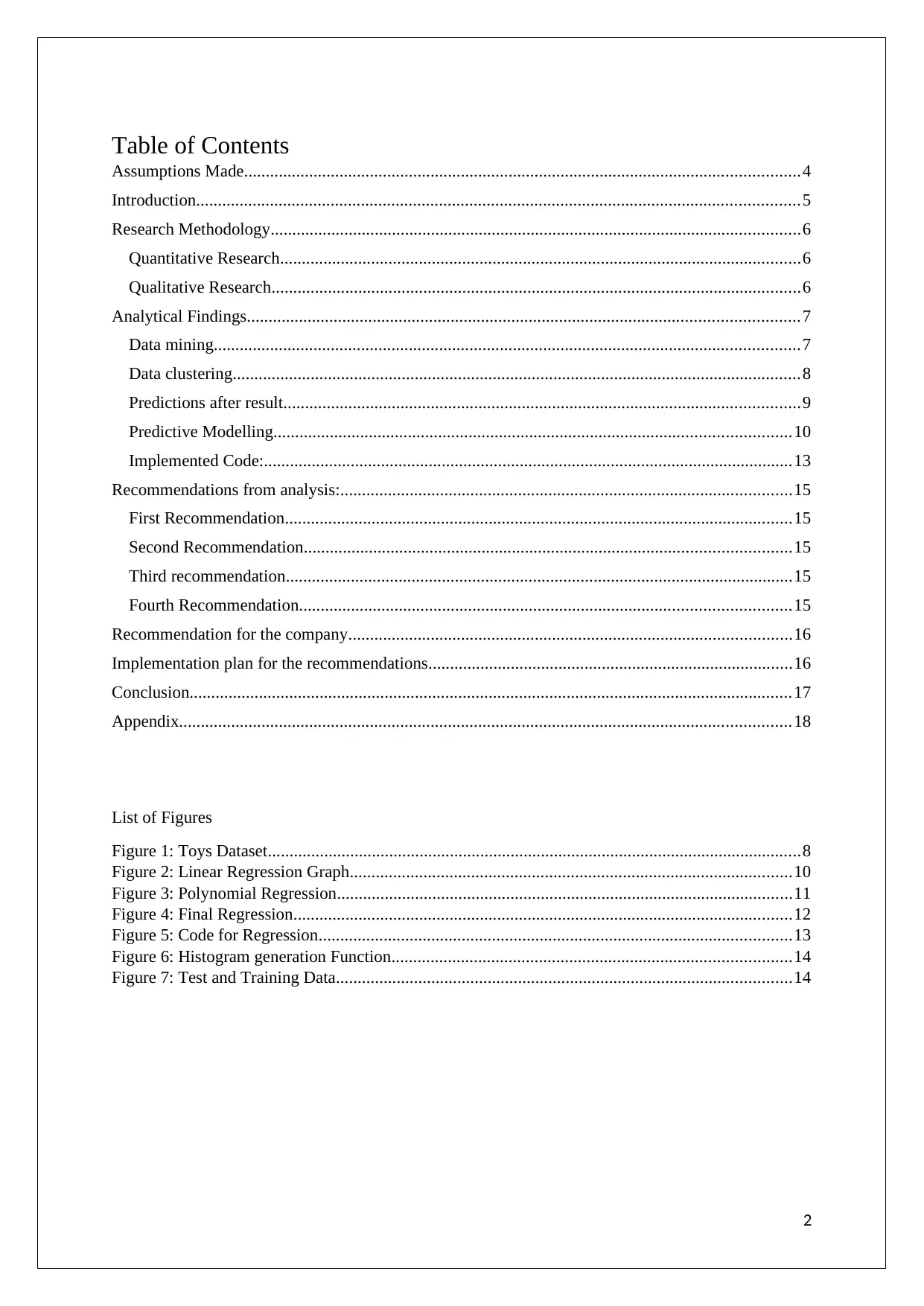
Table of Contents
Assumptions Made................................................................................................................................4
Introduction...........................................................................................................................................5
Research Methodology..........................................................................................................................6
Quantitative Research........................................................................................................................6
Qualitative Research..........................................................................................................................6
Analytical Findings...............................................................................................................................7
Data mining.......................................................................................................................................7
Data clustering...................................................................................................................................8
Predictions after result.......................................................................................................................9
Predictive Modelling.......................................................................................................................10
Implemented Code:..........................................................................................................................13
Recommendations from analysis:........................................................................................................15
First Recommendation.....................................................................................................................15
Second Recommendation................................................................................................................15
Third recommendation.....................................................................................................................15
Fourth Recommendation.................................................................................................................15
Recommendation for the company......................................................................................................16
Implementation plan for the recommendations....................................................................................16
Conclusion...........................................................................................................................................17
Appendix.............................................................................................................................................18
List of Figures
Figure 1: Toys Dataset...........................................................................................................................8
Figure 2: Linear Regression Graph......................................................................................................10
Figure 3: Polynomial Regression.........................................................................................................11
Figure 4: Final Regression...................................................................................................................12
Figure 5: Code for Regression.............................................................................................................13
Figure 6: Histogram generation Function............................................................................................14
Figure 7: Test and Training Data.........................................................................................................14
2
Assumptions Made................................................................................................................................4
Introduction...........................................................................................................................................5
Research Methodology..........................................................................................................................6
Quantitative Research........................................................................................................................6
Qualitative Research..........................................................................................................................6
Analytical Findings...............................................................................................................................7
Data mining.......................................................................................................................................7
Data clustering...................................................................................................................................8
Predictions after result.......................................................................................................................9
Predictive Modelling.......................................................................................................................10
Implemented Code:..........................................................................................................................13
Recommendations from analysis:........................................................................................................15
First Recommendation.....................................................................................................................15
Second Recommendation................................................................................................................15
Third recommendation.....................................................................................................................15
Fourth Recommendation.................................................................................................................15
Recommendation for the company......................................................................................................16
Implementation plan for the recommendations....................................................................................16
Conclusion...........................................................................................................................................17
Appendix.............................................................................................................................................18
List of Figures
Figure 1: Toys Dataset...........................................................................................................................8
Figure 2: Linear Regression Graph......................................................................................................10
Figure 3: Polynomial Regression.........................................................................................................11
Figure 4: Final Regression...................................................................................................................12
Figure 5: Code for Regression.............................................................................................................13
Figure 6: Histogram generation Function............................................................................................14
Figure 7: Test and Training Data.........................................................................................................14
2
⊘ This is a preview!⊘
Do you want full access?
Subscribe today to unlock all pages.

Trusted by 1+ million students worldwide
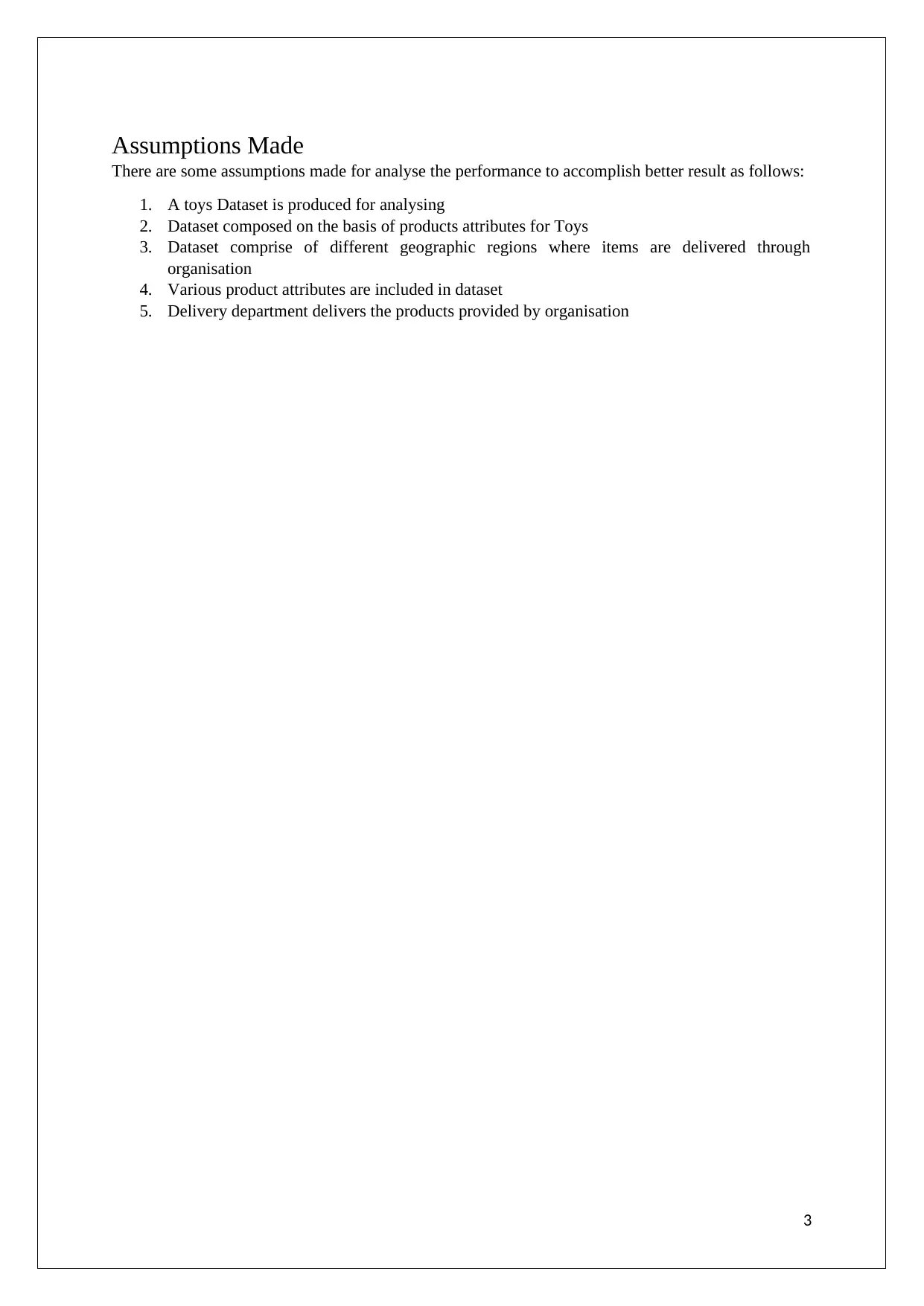
Assumptions Made
There are some assumptions made for analyse the performance to accomplish better result as follows:
1. A toys Dataset is produced for analysing
2. Dataset composed on the basis of products attributes for Toys
3. Dataset comprise of different geographic regions where items are delivered through
organisation
4. Various product attributes are included in dataset
5. Delivery department delivers the products provided by organisation
3
There are some assumptions made for analyse the performance to accomplish better result as follows:
1. A toys Dataset is produced for analysing
2. Dataset composed on the basis of products attributes for Toys
3. Dataset comprise of different geographic regions where items are delivered through
organisation
4. Various product attributes are included in dataset
5. Delivery department delivers the products provided by organisation
3
Paraphrase This Document
Need a fresh take? Get an instant paraphrase of this document with our AI Paraphraser
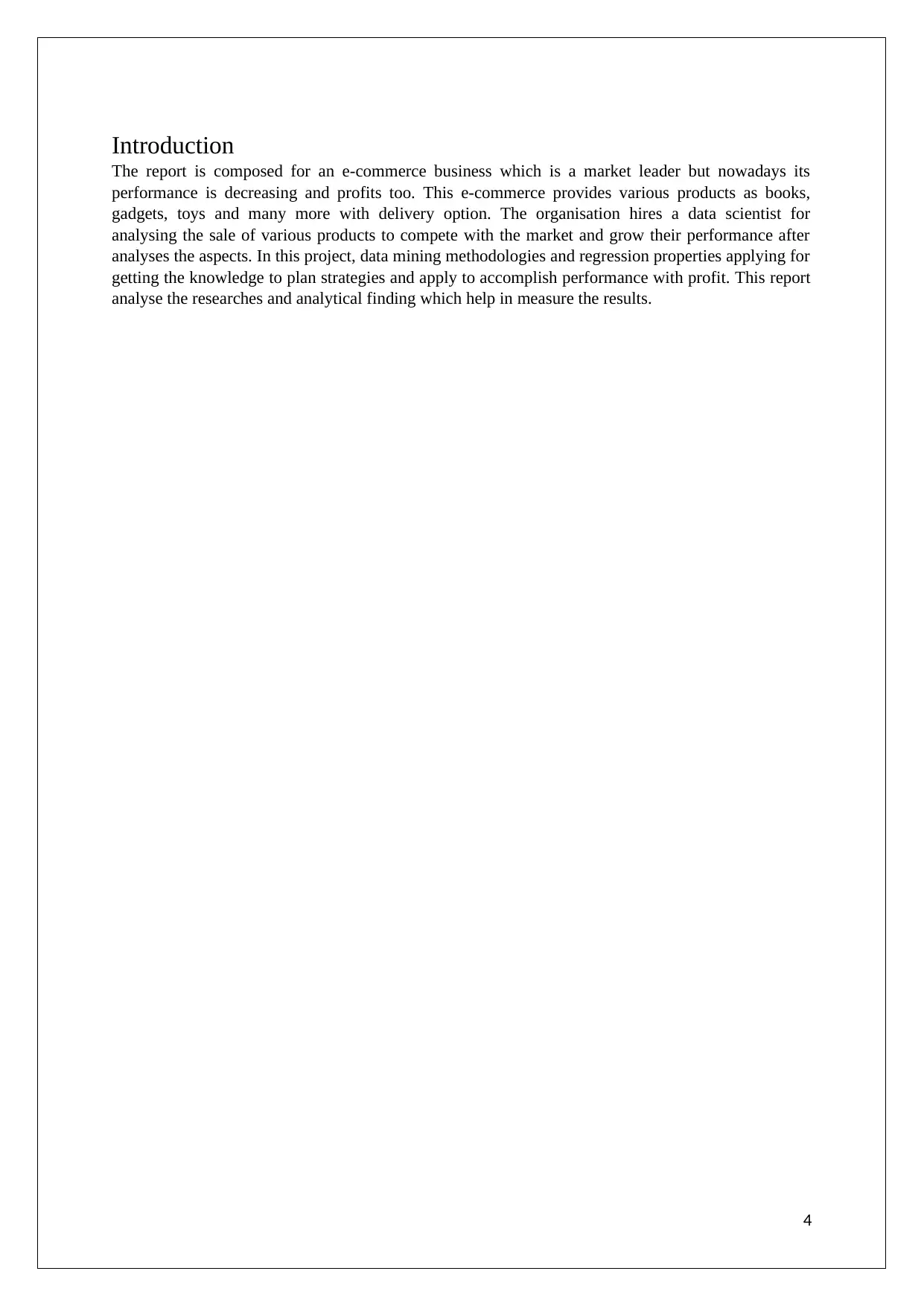
Introduction
The report is composed for an e-commerce business which is a market leader but nowadays its
performance is decreasing and profits too. This e-commerce provides various products as books,
gadgets, toys and many more with delivery option. The organisation hires a data scientist for
analysing the sale of various products to compete with the market and grow their performance after
analyses the aspects. In this project, data mining methodologies and regression properties applying for
getting the knowledge to plan strategies and apply to accomplish performance with profit. This report
analyse the researches and analytical finding which help in measure the results.
4
The report is composed for an e-commerce business which is a market leader but nowadays its
performance is decreasing and profits too. This e-commerce provides various products as books,
gadgets, toys and many more with delivery option. The organisation hires a data scientist for
analysing the sale of various products to compete with the market and grow their performance after
analyses the aspects. In this project, data mining methodologies and regression properties applying for
getting the knowledge to plan strategies and apply to accomplish performance with profit. This report
analyse the researches and analytical finding which help in measure the results.
4
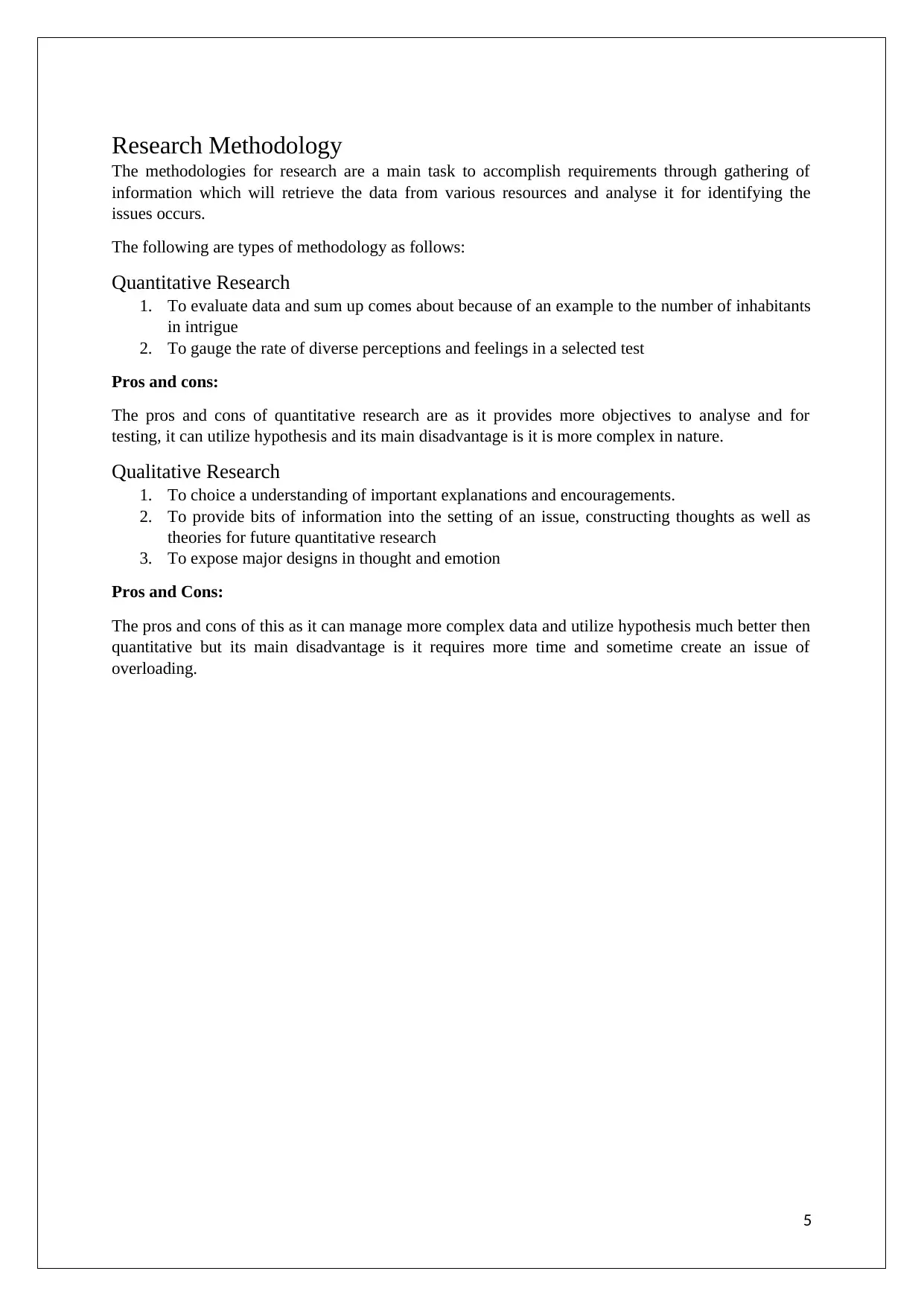
Research Methodology
The methodologies for research are a main task to accomplish requirements through gathering of
information which will retrieve the data from various resources and analyse it for identifying the
issues occurs.
The following are types of methodology as follows:
Quantitative Research
1. To evaluate data and sum up comes about because of an example to the number of inhabitants
in intrigue
2. To gauge the rate of diverse perceptions and feelings in a selected test
Pros and cons:
The pros and cons of quantitative research are as it provides more objectives to analyse and for
testing, it can utilize hypothesis and its main disadvantage is it is more complex in nature.
Qualitative Research
1. To choice a understanding of important explanations and encouragements.
2. To provide bits of information into the setting of an issue, constructing thoughts as well as
theories for future quantitative research
3. To expose major designs in thought and emotion
Pros and Cons:
The pros and cons of this as it can manage more complex data and utilize hypothesis much better then
quantitative but its main disadvantage is it requires more time and sometime create an issue of
overloading.
5
The methodologies for research are a main task to accomplish requirements through gathering of
information which will retrieve the data from various resources and analyse it for identifying the
issues occurs.
The following are types of methodology as follows:
Quantitative Research
1. To evaluate data and sum up comes about because of an example to the number of inhabitants
in intrigue
2. To gauge the rate of diverse perceptions and feelings in a selected test
Pros and cons:
The pros and cons of quantitative research are as it provides more objectives to analyse and for
testing, it can utilize hypothesis and its main disadvantage is it is more complex in nature.
Qualitative Research
1. To choice a understanding of important explanations and encouragements.
2. To provide bits of information into the setting of an issue, constructing thoughts as well as
theories for future quantitative research
3. To expose major designs in thought and emotion
Pros and Cons:
The pros and cons of this as it can manage more complex data and utilize hypothesis much better then
quantitative but its main disadvantage is it requires more time and sometime create an issue of
overloading.
5
⊘ This is a preview!⊘
Do you want full access?
Subscribe today to unlock all pages.

Trusted by 1+ million students worldwide
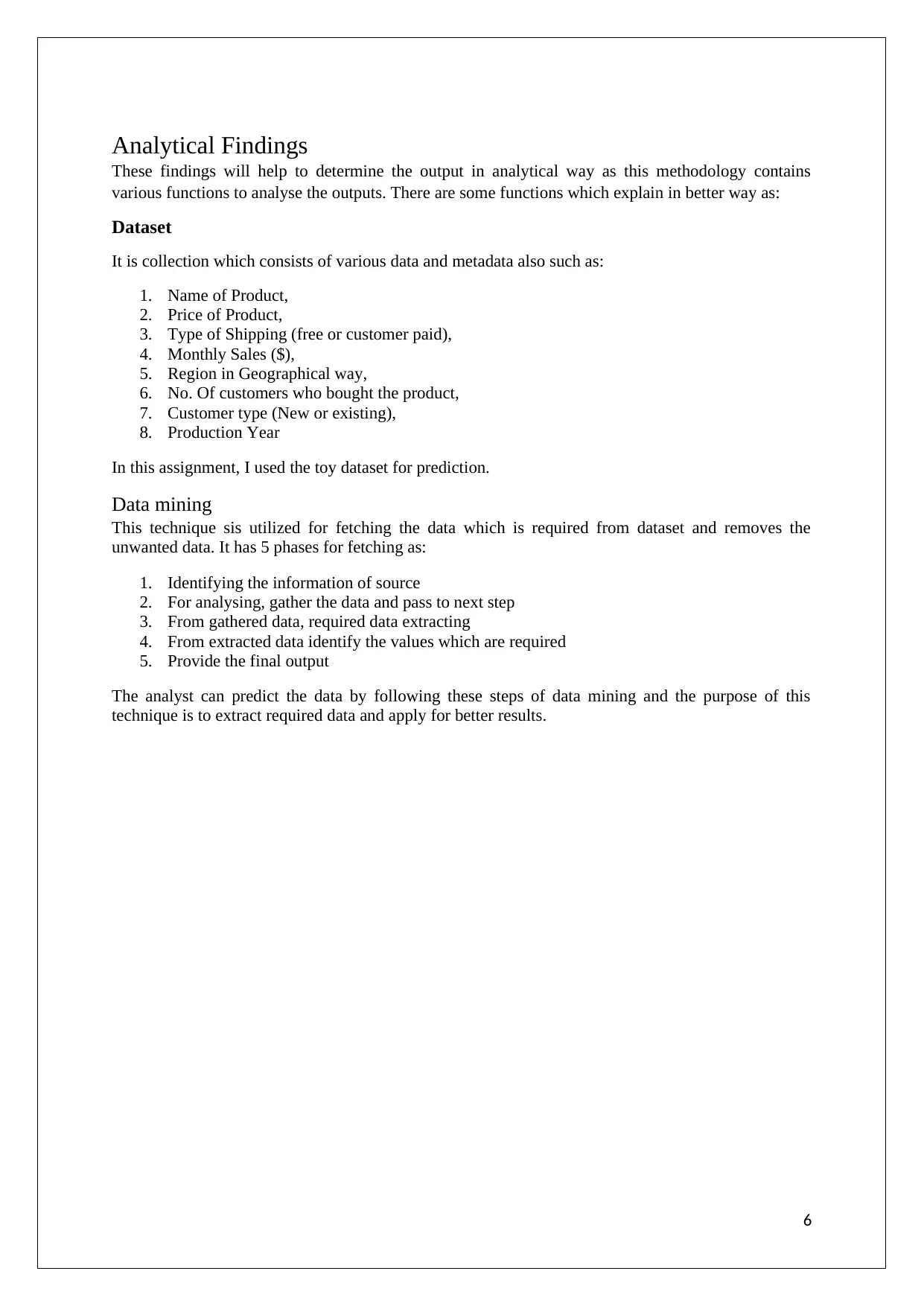
Analytical Findings
These findings will help to determine the output in analytical way as this methodology contains
various functions to analyse the outputs. There are some functions which explain in better way as:
Dataset
It is collection which consists of various data and metadata also such as:
1. Name of Product,
2. Price of Product,
3. Type of Shipping (free or customer paid),
4. Monthly Sales ($),
5. Region in Geographical way,
6. No. Of customers who bought the product,
7. Customer type (New or existing),
8. Production Year
In this assignment, I used the toy dataset for prediction.
Data mining
This technique sis utilized for fetching the data which is required from dataset and removes the
unwanted data. It has 5 phases for fetching as:
1. Identifying the information of source
2. For analysing, gather the data and pass to next step
3. From gathered data, required data extracting
4. From extracted data identify the values which are required
5. Provide the final output
The analyst can predict the data by following these steps of data mining and the purpose of this
technique is to extract required data and apply for better results.
6
These findings will help to determine the output in analytical way as this methodology contains
various functions to analyse the outputs. There are some functions which explain in better way as:
Dataset
It is collection which consists of various data and metadata also such as:
1. Name of Product,
2. Price of Product,
3. Type of Shipping (free or customer paid),
4. Monthly Sales ($),
5. Region in Geographical way,
6. No. Of customers who bought the product,
7. Customer type (New or existing),
8. Production Year
In this assignment, I used the toy dataset for prediction.
Data mining
This technique sis utilized for fetching the data which is required from dataset and removes the
unwanted data. It has 5 phases for fetching as:
1. Identifying the information of source
2. For analysing, gather the data and pass to next step
3. From gathered data, required data extracting
4. From extracted data identify the values which are required
5. Provide the final output
The analyst can predict the data by following these steps of data mining and the purpose of this
technique is to extract required data and apply for better results.
6
Paraphrase This Document
Need a fresh take? Get an instant paraphrase of this document with our AI Paraphraser
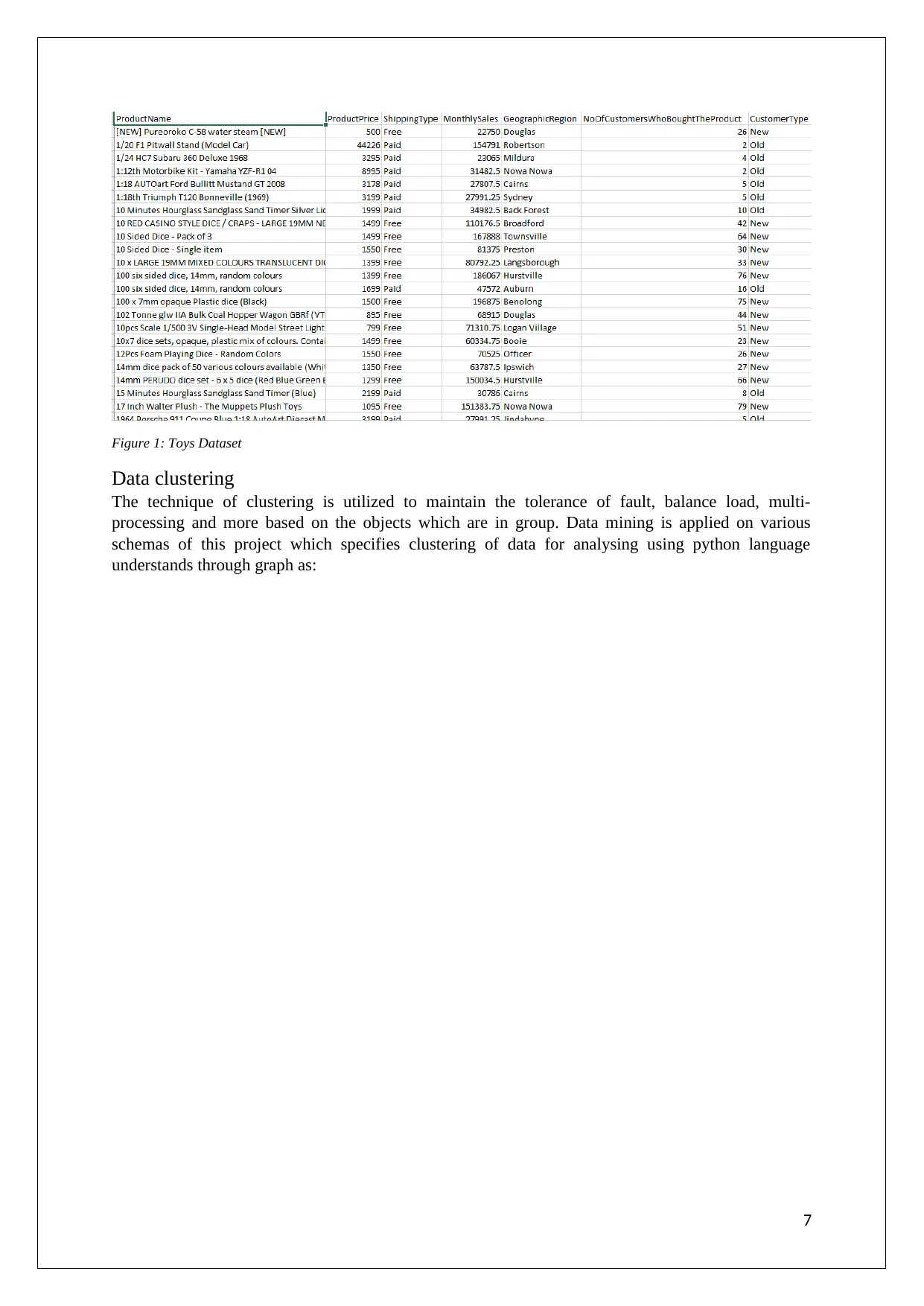
Figure 1: Toys Dataset
Data clustering
The technique of clustering is utilized to maintain the tolerance of fault, balance load, multi-
processing and more based on the objects which are in group. Data mining is applied on various
schemas of this project which specifies clustering of data for analysing using python language
understands through graph as:
7
Data clustering
The technique of clustering is utilized to maintain the tolerance of fault, balance load, multi-
processing and more based on the objects which are in group. Data mining is applied on various
schemas of this project which specifies clustering of data for analysing using python language
understands through graph as:
7
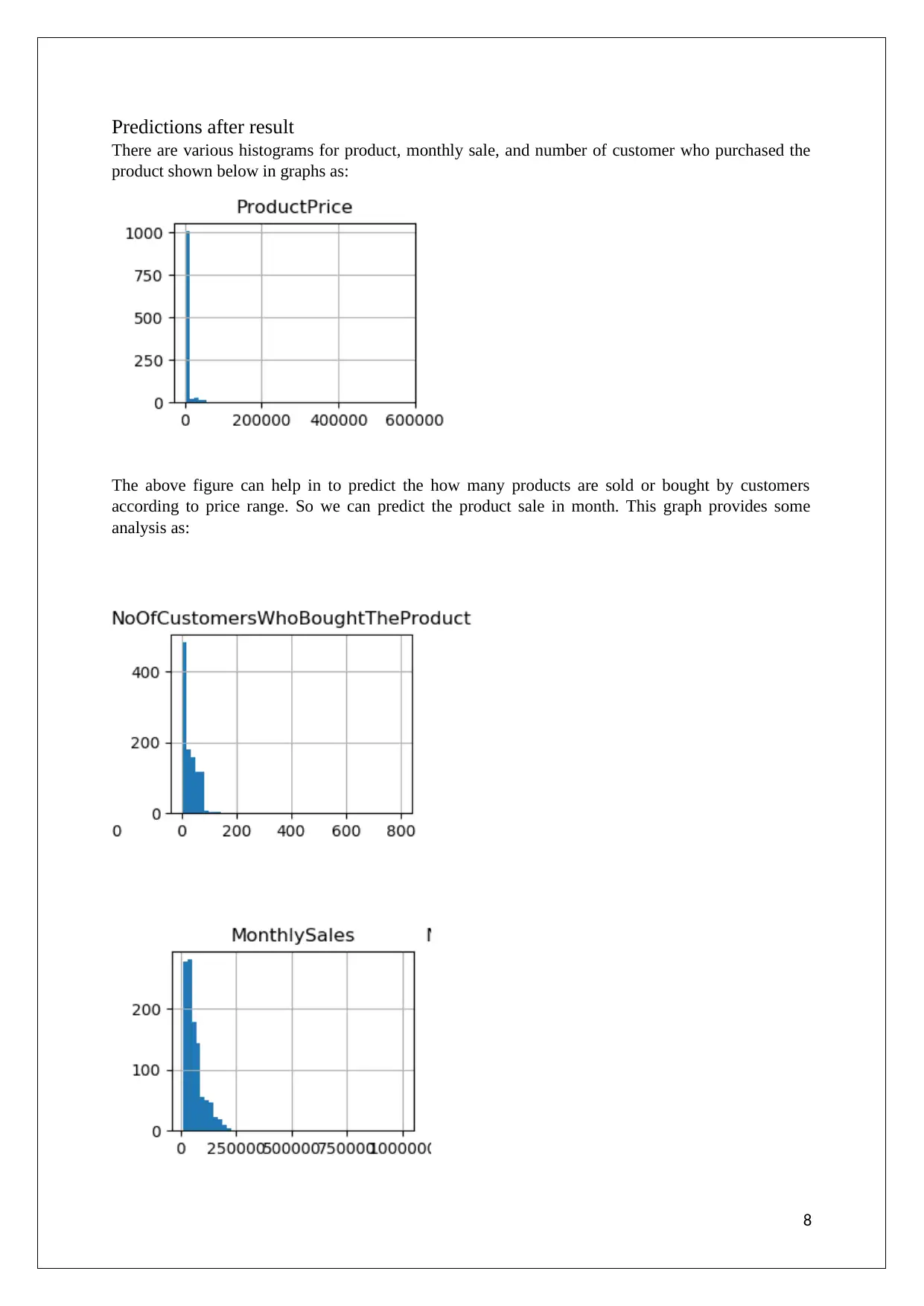
Predictions after result
There are various histograms for product, monthly sale, and number of customer who purchased the
product shown below in graphs as:
The above figure can help in to predict the how many products are sold or bought by customers
according to price range. So we can predict the product sale in month. This graph provides some
analysis as:
8
There are various histograms for product, monthly sale, and number of customer who purchased the
product shown below in graphs as:
The above figure can help in to predict the how many products are sold or bought by customers
according to price range. So we can predict the product sale in month. This graph provides some
analysis as:
8
⊘ This is a preview!⊘
Do you want full access?
Subscribe today to unlock all pages.

Trusted by 1+ million students worldwide
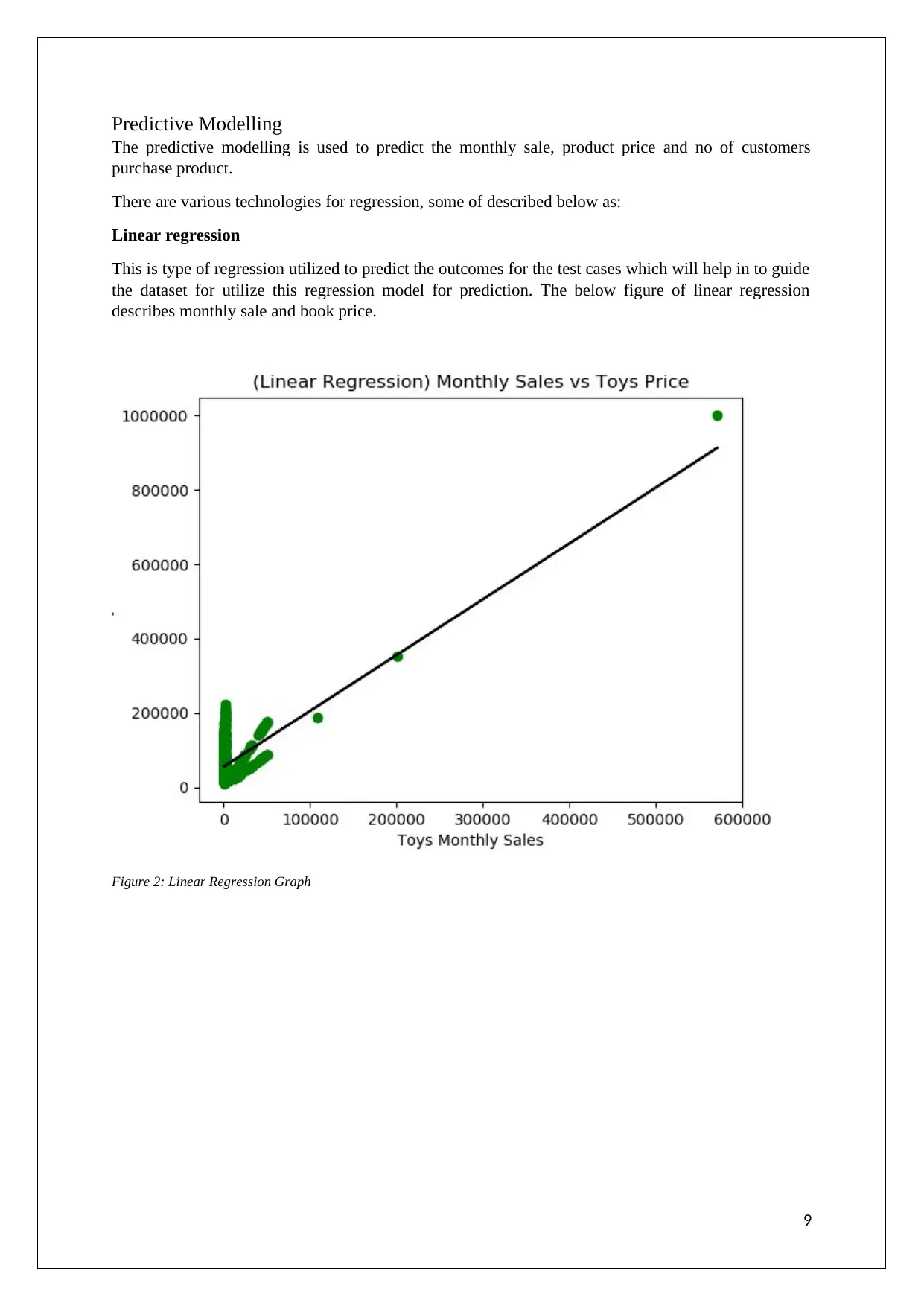
Predictive Modelling
The predictive modelling is used to predict the monthly sale, product price and no of customers
purchase product.
There are various technologies for regression, some of described below as:
Linear regression
This is type of regression utilized to predict the outcomes for the test cases which will help in to guide
the dataset for utilize this regression model for prediction. The below figure of linear regression
describes monthly sale and book price.
Figure 2: Linear Regression Graph
9
The predictive modelling is used to predict the monthly sale, product price and no of customers
purchase product.
There are various technologies for regression, some of described below as:
Linear regression
This is type of regression utilized to predict the outcomes for the test cases which will help in to guide
the dataset for utilize this regression model for prediction. The below figure of linear regression
describes monthly sale and book price.
Figure 2: Linear Regression Graph
9
Paraphrase This Document
Need a fresh take? Get an instant paraphrase of this document with our AI Paraphraser
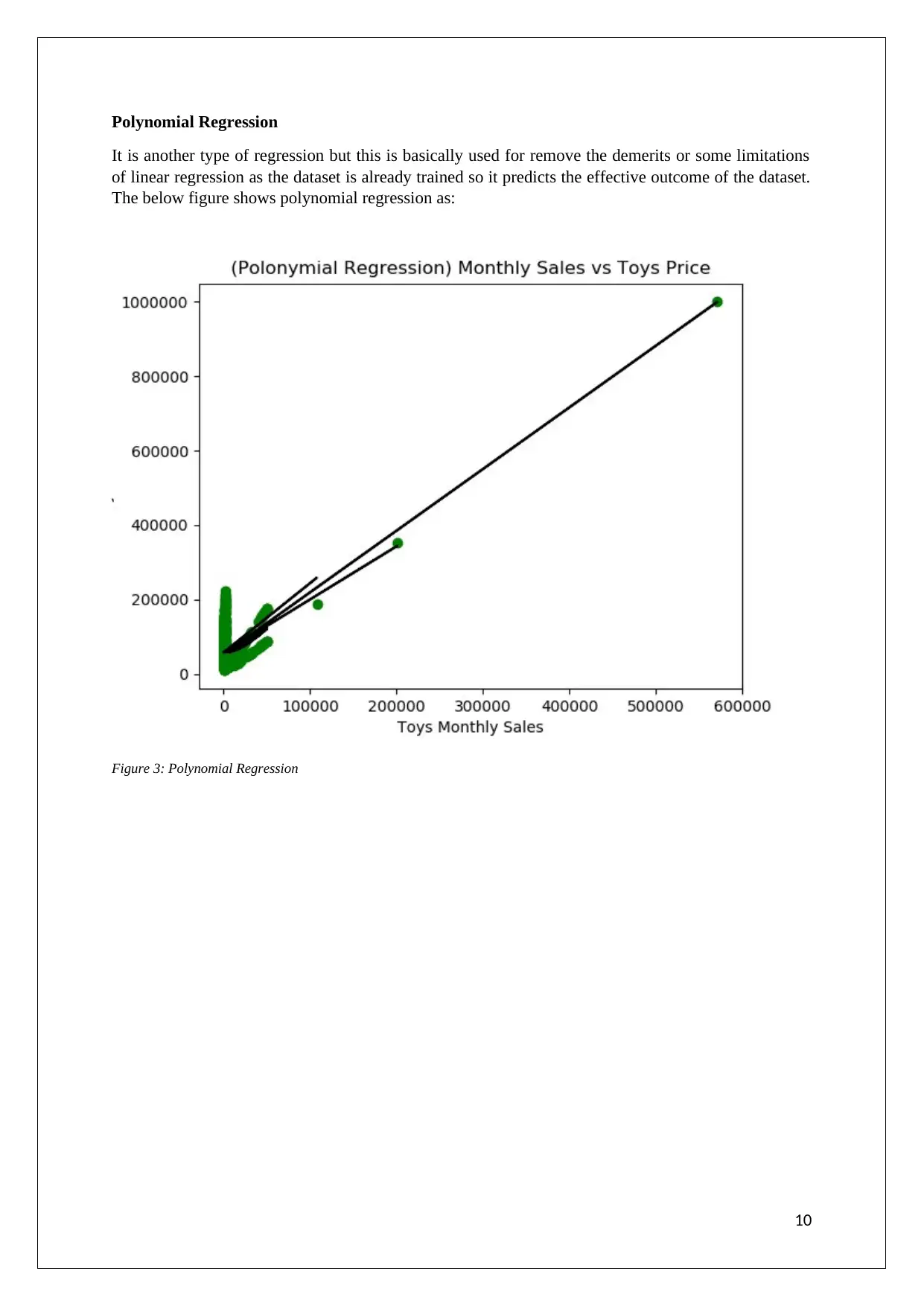
Polynomial Regression
It is another type of regression but this is basically used for remove the demerits or some limitations
of linear regression as the dataset is already trained so it predicts the effective outcome of the dataset.
The below figure shows polynomial regression as:
Figure 3: Polynomial Regression
10
It is another type of regression but this is basically used for remove the demerits or some limitations
of linear regression as the dataset is already trained so it predicts the effective outcome of the dataset.
The below figure shows polynomial regression as:
Figure 3: Polynomial Regression
10
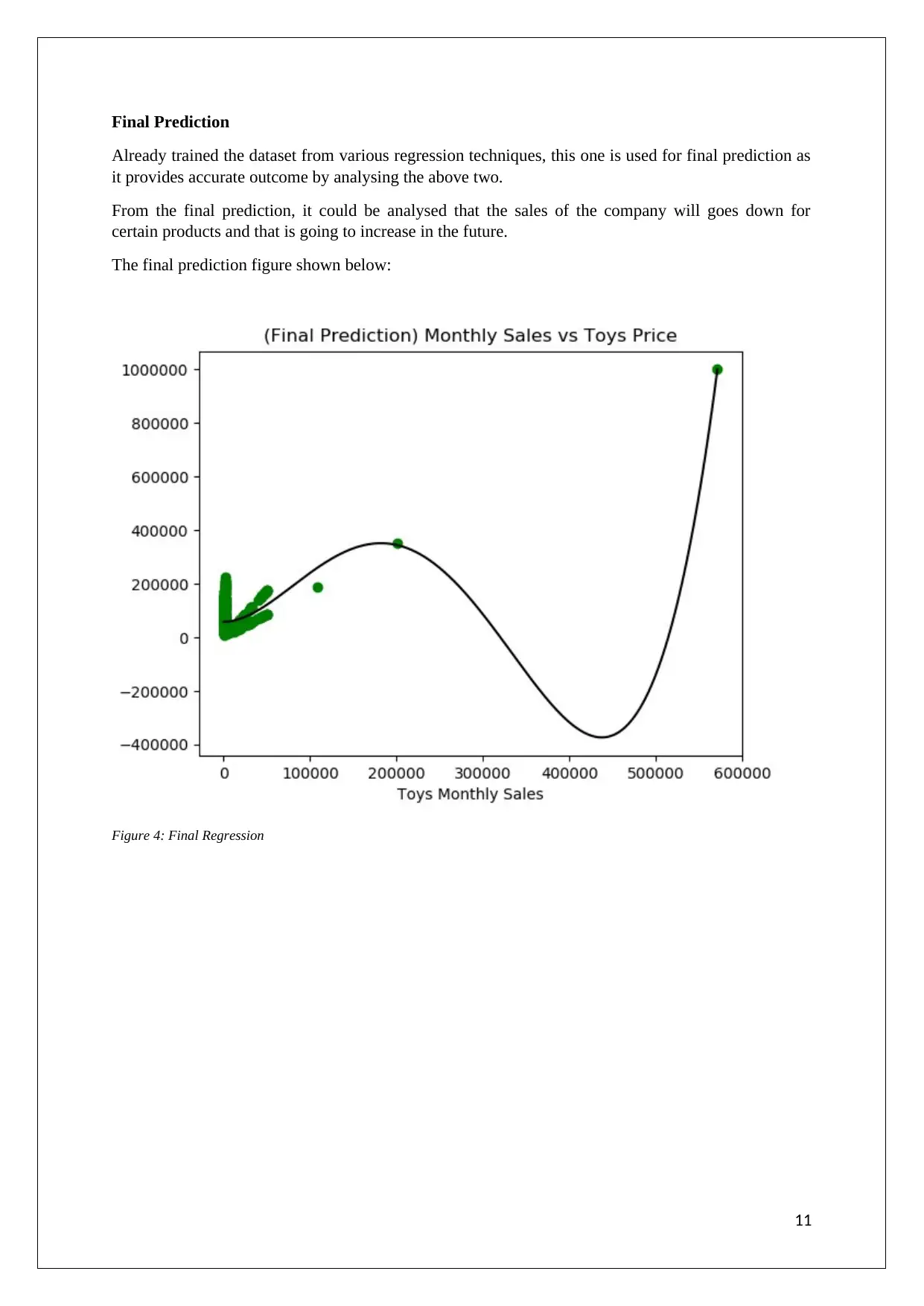
Final Prediction
Already trained the dataset from various regression techniques, this one is used for final prediction as
it provides accurate outcome by analysing the above two.
From the final prediction, it could be analysed that the sales of the company will goes down for
certain products and that is going to increase in the future.
The final prediction figure shown below:
Figure 4: Final Regression
11
Already trained the dataset from various regression techniques, this one is used for final prediction as
it provides accurate outcome by analysing the above two.
From the final prediction, it could be analysed that the sales of the company will goes down for
certain products and that is going to increase in the future.
The final prediction figure shown below:
Figure 4: Final Regression
11
⊘ This is a preview!⊘
Do you want full access?
Subscribe today to unlock all pages.

Trusted by 1+ million students worldwide
1 out of 18
Related Documents
Your All-in-One AI-Powered Toolkit for Academic Success.
+13062052269
info@desklib.com
Available 24*7 on WhatsApp / Email
![[object Object]](/_next/static/media/star-bottom.7253800d.svg)
Unlock your academic potential
Copyright © 2020–2025 A2Z Services. All Rights Reserved. Developed and managed by ZUCOL.





